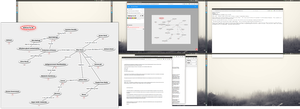Information
- Publication Type: Journal Paper (without talk)
- Workgroup(s)/Project(s):
- Date: January 2021
- DOI: https://doi.org/10.1177/1473871620986249
- Journal: Information Visualization
- Keywords: mind map, concept map, observation graph, visual links, sensemaking
Abstract
Many professionals, like journalists, writers, or consultants, need to acquire information from various sources, make sense of this unstructured evidence, structure their observations, and finally create and deliver their product, such as a report or a presentation. In formative interviews, we found that tools allowing structuring of observations are often disconnected from the corresponding evidence. Therefore, we designed a sensemaking environment with a flexible observation graph that visually ties together evidence in unstructured documents with the user’s structured knowledge. This is achieved through bi-directional deep links between highlighted document portions and nodes in the observation graph. In a controlled study, we compared users’ sensemaking strategies using either the observation graph or a simple text editor on a large display. Results show that the observation graph represents a holistic, compact representation of users’ observations, which can be linked to unstructured evidence on demand. In contrast, users taking textual notes required much more display space to spatially organize source documents containing unstructured evidence. This implies that spatial organization is a powerful strategy to structure observations even if the available space is limited.Additional Files and Images
Weblinks
BibTeX
@article{waldner-2021-leo,
title = "Linking unstructured evidence to structured observations",
author = "Manuela Waldner and Thomas Geymayer and Dieter Schmalstieg
and Michael Sedlmair",
year = "2021",
abstract = "Many professionals, like journalists, writers, or
consultants, need to acquire information from various
sources, make sense of this unstructured evidence, structure
their observations, and finally create and deliver their
product, such as a report or a presentation. In formative
interviews, we found that tools allowing structuring of
observations are often disconnected from the corresponding
evidence. Therefore, we designed a sensemaking environment
with a flexible observation graph that visually ties
together evidence in unstructured documents with the
user’s structured knowledge. This is achieved through
bi-directional deep links between highlighted document
portions and nodes in the observation graph. In a controlled
study, we compared users’ sensemaking strategies using
either the observation graph or a simple text editor on a
large display. Results show that the observation graph
represents a holistic, compact representation of users’
observations, which can be linked to unstructured evidence
on demand. In contrast, users taking textual notes required
much more display space to spatially organize source
documents containing unstructured evidence. This implies
that spatial organization is a powerful strategy to
structure observations even if the available space is
limited.",
month = jan,
doi = "https://doi.org/10.1177/1473871620986249",
journal = "Information Visualization",
keywords = "mind map, concept map, observation graph, visual links,
sensemaking",
URL = "https://www.cg.tuwien.ac.at/research/publications/2021/waldner-2021-leo/",
}


 Paper
Paper preprint
preprint

